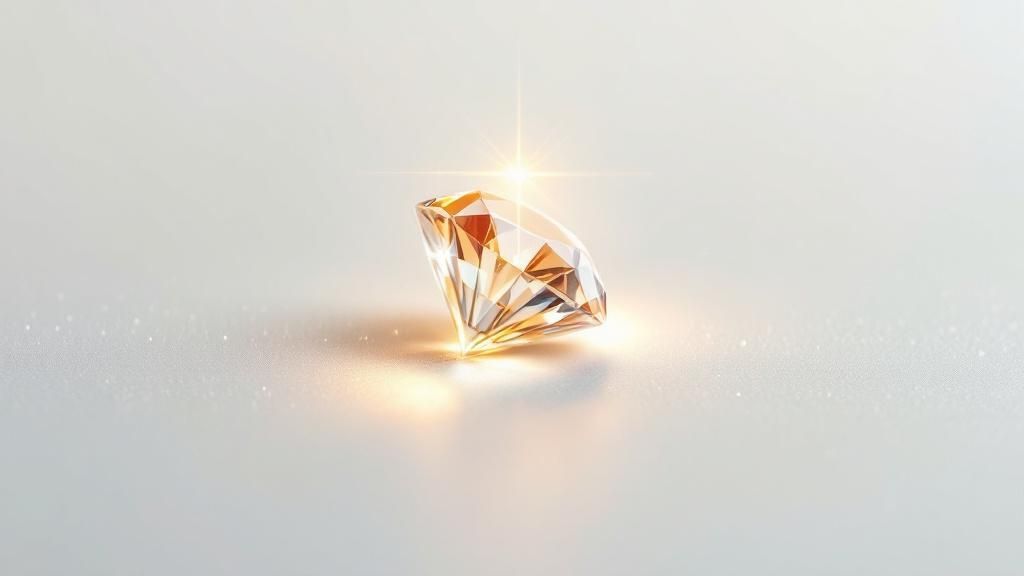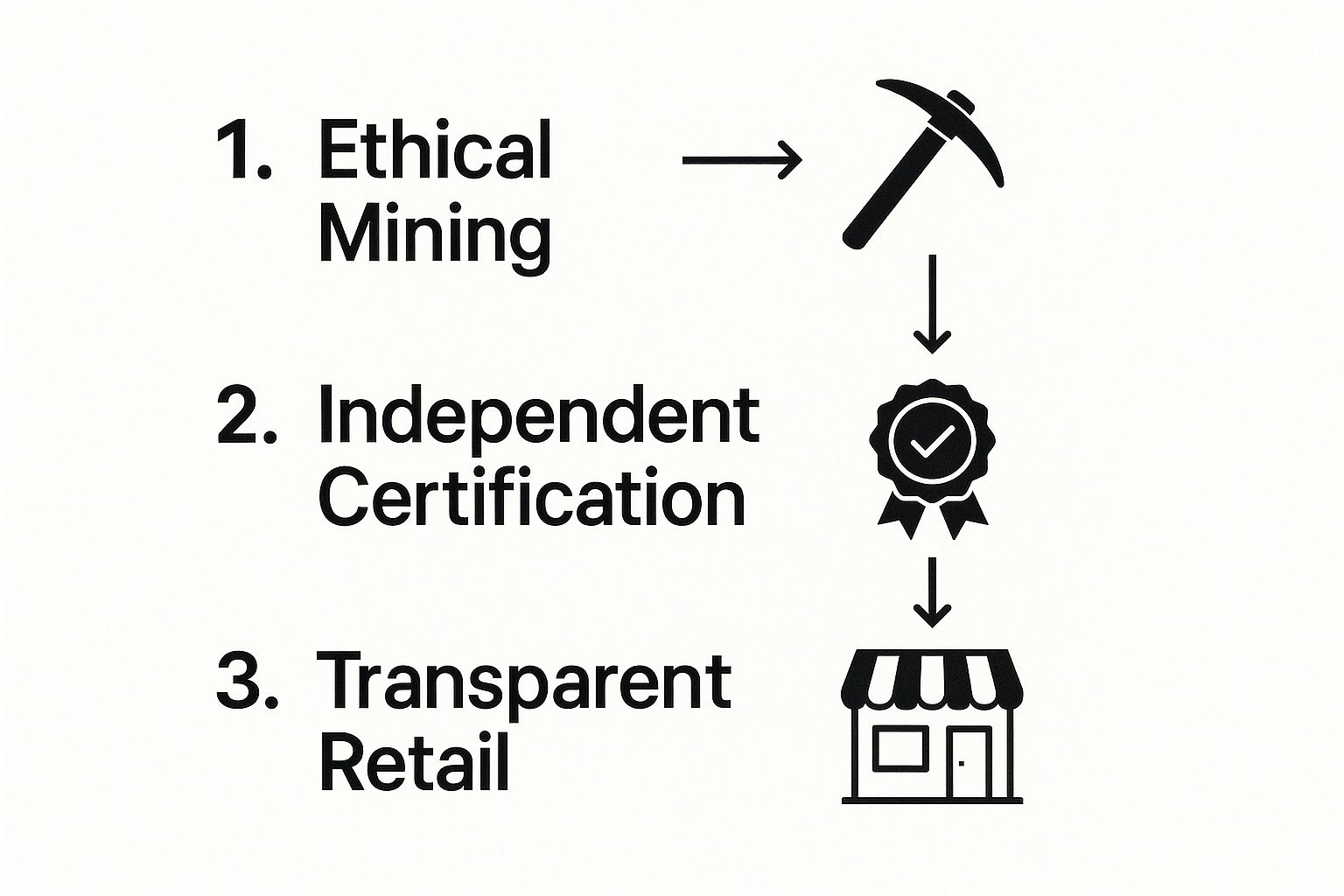What Are Conflict Free Diamonds And How To Buy Ethically
- Luke Zucco
- Aug 3
- 10 min read
So, what exactly is a conflict-free diamond?
At its core, a conflict-free diamond is one that hasn't financed civil wars or armed rebellions. The simplest way to think about it is like fair-trade coffee or ethically sourced cocoa. It's a guarantee that the beautiful gem you're purchasing didn't contribute to violence or exploitation.
This standard represents a huge step toward ethical transparency in the often-opaque world of jewelry.
A Quick Comparison: Conflict-Free vs. Blood Diamonds
To really understand the difference, a side-by-side look can be incredibly helpful. This table breaks down the fundamental distinctions between these two types of diamonds.
Essentially, the choice comes down to supporting either legitimate, peaceful commerce or fueling cycles of violence.
Where Did The "Conflict-Free" Term Come From?

The idea of a "conflict-free" diamond didn't just appear out of thin air. It was born from the grim reality of "blood diamonds," a term that rightfully shocked the world in the 1990s. News reports began exposing how diamond sales were bankrolling horrific armed conflicts in countries across Africa.
This gut-wrenching realization sparked a global outcry for accountability. People wanted to know where their diamonds were really coming from.
In response to this pressure, the diamond industry and international governments came together to create the Kimberley Process Certification Scheme (KPCS) in 2003. This landmark agreement established a system to certify that shipments of rough diamonds were not sourced from war-torn regions. You can dig deeper into the history and impact of the Kimberley Process to see how it changed the industry.
The promise of a conflict-free diamond is both simple and profound: its journey from a mine to your jewelry box did not fund a war, support a rebel army, or enable human rights violations.
This was a critical first step. It gave consumers a reason to believe their purchases were supporting ethical trade. Since then, the conversation has continued to evolve, with many in the industry pushing for even stricter standards that encompass all human rights and environmental concerns, not just war.
How The Kimberley Process Works
To clean up the global diamond trade and stop the flow of blood diamonds, the industry needed a gatekeeper. That need gave rise to the Kimberley Process Certification Scheme (KPCS) in 2003, a groundbreaking collaboration between governments, the diamond industry, and civil society groups.
The best way to think about it is like a passport for diamonds. For a rough diamond to be legally shipped out of a member country, it has to be packed in a special tamper-proof container. Tucked inside with it is a government-validated Kimberley Process certificate, which essentially declares that the diamonds inside are from a conflict-free source.
The Journey of a Certified Diamond
The KPCS is built on a series of checks and balances that shadow a diamond from the moment it's unearthed to the moment it reaches the retail counter. Every country participating in the scheme agrees to trade only with other members. They also commit to enforcing tight internal controls over their own diamond production and trade.
So, a shipment of rough diamonds from a mine in Botswana gets sealed and certified before it can even leave the country. When it lands in a major cutting center like Antwerp, customs officials are there to verify the seal and check the certificate before it's allowed in. This exact process repeats every single time the diamonds cross a border.
The infographic below gives you a simplified look at this journey toward a more transparent diamond trade.

This visual shows the ideal path, where ethical mining, independent certification, and transparent retail all come together to ensure the diamond that reaches you is genuinely conflict-free.
Gaps in the System
There's no doubt this international system has made a huge dent, significantly reducing the number of conflict diamonds on the global market. Still, the Kimberley Process isn't perfect. It has faced criticism over the years for enforcement gaps and a surprisingly narrow scope, but it was the first massive, coordinated effort to bring some accountability to the diamond trade. You can learn more about the diamond industry's path to transparency and how it continues to change.
The Kimberley Process defines a "conflict diamond" very specifically: it only covers gems that fund rebel movements fighting against recognized governments. It doesn't account for other major ethical problems like human rights abuses, terrible working conditions, or environmental destruction.
Because of these significant blind spots, many experts now view the KPCS as a foundational first step, not the final word on what makes a diamond ethical. This has pushed the industry to create its own higher standards that look at a much broader range of ethical concerns.
Moving Beyond Conflict-Free To Ethical Sourcing

While the Kimberley Process was a crucial first step, its definition of "conflict-free" is surprisingly narrow. It really only focuses on one thing: stopping the trade of rough diamonds used by rebel movements to finance wars against legitimate governments. This leaves a lot of other serious ethical problems unaddressed, from human rights abuses and dangerous working conditions to environmental devastation.
It helps to think about diamond ethics on a spectrum. At one end, you have the basic "conflict-free" label. It's a low bar, essentially meaning the diamond didn't fund a war. At the far other end is a truly ethical diamond, which considers the stone’s entire journey—from the moment it's pulled from the earth to the second it's set in a ring. This comprehensive view ensures the diamond's story is one of dignity and sustainability.
For a growing number of us, simply avoiding conflict diamonds isn’t cutting it anymore. We want to know that the jewelry we buy actively supports communities and, at the very least, does no harm.
The New Standard Of Ethical Sourcing
This shift in consumer awareness is pushing the diamond industry to adopt much higher standards. The modern definition of an ethical diamond goes far beyond the original conflict-free concept. It now encompasses fair labor, environmental responsibility, and positive community impact. To find diamonds that meet these tougher criteria, look for certifications from groups like the Responsible Jewellery Council (RJC) or Fairmined, which champion transparency and accountability.
These certifications are far more than just a piece of paper; they represent a deep-seated commitment to improving the industry from the inside out. They dig into a whole host of factors, including:
Worker Safety and Fair Pay: Making sure miners have safe working environments and are paid a living wage for their hard work.
Environmental Protection: Holding mining operations accountable for minimizing their ecological footprint and rehabilitating the land once they’re done.
Community Investment: Ensuring a share of the profits flows back into local communities to fund schools, healthcare, and vital infrastructure.
A truly ethical diamond tells a story of empowerment, not just the absence of conflict. It reflects a commitment to supporting the people and places that bring these beautiful gems to light.
A great example is a Fairmined-certified operation in Sierra Leone. It wouldn’t just guarantee its diamonds are conflict-free; it would also use its revenue to build a new school or provide healthcare for miners and their families. This is the new benchmark for ethical jewelry. To see which companies are leading the charge, take a look at our guide to the top ethical jewelry brands for 2025.
How To Verify A Diamond Is Conflict-Free
Alright, so you understand the standards, but how does that translate to actually buying a diamond? The truth is, it comes down to you. As the customer, you hold the power to ask the tough questions and insist on transparency.
Think of it this way: you walk into two different jewelry stores. In the first, the salesperson gives you a vague smile and says, "Oh yes, all our diamonds are clean." In the second store, the jeweler pulls out the paperwork, points to a laser inscription on the diamond itself, and walks you through their entire sourcing policy. Which one makes you feel more confident? It’s not even a contest. Proof beats a simple promise every time.
To make sure you get that proof, here’s a practical checklist to use when you're shopping. This isn't about being difficult; it's about being an informed buyer. A truly reputable jeweler will welcome your questions and have the answers ready.
Your Conflict-Free Shopping Checklist
Here are four essential steps to take to confirm a diamond's ethical journey.
Ask for a System of Warranties Statement: This is your first line of defense. Reputable jewelers should have a written statement right on the invoice or receipt declaring their diamonds are conflict-free, in line with the Kimberley Process. It’s a paper trail of assurance passed down from the diamond cutter to the store.
Request Traceability Reports: Don't stop at the warranty statement. Ask for more. Can the jeweler show you documents that trace the diamond back to its country of origin? While tracking a stone from the specific mine to the store is still the gold standard and not always possible, they should absolutely be able to identify the source country.
Look for a Laser Inscription: Many modern diamonds certified by labs like the Gemological Institute of America (GIA) have a tiny serial number laser-inscribed on the diamond's edge (the girdle). It’s invisible to the naked eye but can be seen under magnification. This number matches the one on the official grading report, locking the stone to its documented origins.
Choose Reputable Jewelers: Stick with retailers who are open and proud of their sourcing policies. A great sign is membership in organizations like the Responsible Jewellery Council (RJC), which holds members to high ethical standards. Look for jewelers who don't just say they're ethical—they show you how.
The most powerful tool you have is your own voice. Simply asking, "Can you show me this diamond's origin report?" sends a clear message to the entire industry that customers care deeply about where their gems come from.
Taking these steps helps you make a purchase you can feel good about for a lifetime. For more great advice on making smart jewelry decisions, check out these [8 essential jewelry buying tips for 2025](https://www.pantherdeluxe.com/post/8-essential-jewelry-buying-tips-for-2025) to help you shop with total confidence.
Are Lab-Grown Diamonds Always Conflict-Free?

With all the heavy history tied to mined diamonds, it's natural to see lab-grown stones as the clear, ethical winner. And in one crucial way, they are. Because they’re grown in a controlled laboratory setting, they completely sidestep the entire issue of funding conflict or being tied to dangerous mining conditions.
This guarantee alone gives many people the peace of mind they’re looking for when buying a diamond. But the story doesn’t end there. While lab-grown diamonds are free from the "conflict" that the Kimberley Process was designed to stop, the conversation around what makes a diamond truly “ethical” has broadened.
Today, ethical considerations include environmental impact and labor practices. For lab-grown diamonds, the biggest question mark hangs over their energy consumption.
The Energy Footprint of Lab Diamonds
Growing a diamond takes an incredible amount of energy to replicate the intense heat and pressure found deep within the Earth. Where that energy comes from is what separates one lab-grown diamond from another.
A lab running on fossil fuels leaves a very different footprint than one powered by solar or wind. This is where the environmental ethics come into play—not all lab diamonds are created equal.
The ethical story of a lab-grown diamond isn't about avoiding conflict—it's about understanding its carbon journey. A diamond created with clean energy tells a much more sustainable story than one made using coal.
Think of it this way: one producer might proudly state they run on 100% renewable energy, making their diamonds a truly low-impact choice. Another might rely on a local grid powered by coal, which carries its own environmental baggage. The end product might look identical, but their journeys are worlds apart.
While we can confidently say lab-grown diamonds are conflict-free by definition, their overall ethical standing can still vary. This is why it’s so important to understand how diamond sourcing continues to evolve to meet our modern standards.
Ultimately, when you choose a lab-grown diamond, you're asking a different set of ethical questions. It's less about wars and more about watts.
Why Ethical Diamonds Matter In The Market
Today's shoppers don't just buy a product; they invest in the story behind it. This change in mindset is shaking up the diamond industry, where a gem's journey from mine to market is suddenly just as critical as its cut, color, or clarity. Consumers are using their spending power to demand more transparency and accountability from jewelers.
This powerful movement is primarily fueled by younger buyers, particularly Millennials and Gen Z, who place a high value on sustainable and responsible sourcing. The numbers back this up. The global diamond market is expected to hit USD 50.23 billion by 2030, and a huge part of that growth is coming from the demand for ethical stones. You can explore the data for yourself and see its impact on the global diamond market on Grandview Research.
Every purchase sends a signal. When you choose a diamond with a transparent, ethical history, you're telling the entire industry that responsible sourcing isn't just a preference—it's a requirement.
Brands that are getting ahead of this curve are thriving. Some jewelers who have committed to full traceability have seen major boosts in sales, proving that doing the right thing is also good for business. This creates a ripple effect, encouraging more suppliers to clean up their acts and ensure their diamonds are sourced responsibly.
If you're interested in the hands-on side of gems, our guide on how to identify gemstones at home offers some great starting tips.
Your Top Questions About Conflict-Free Diamonds
When you're ready to buy a diamond, a few last questions often pop up. It's smart to get them answered so you can feel completely confident in your choice.
Do Conflict-Free Diamonds Cost More?
You might think that an ethically sourced diamond comes with a higher price tag, but that’s generally not the case. Think of it this way: the Kimberley Process and similar standards have set a new normal for the industry.
Any jeweler you'd want to buy from already deals exclusively in conflict-free diamonds, so the cost is simply part of the standard market price. The factors that really drive the price up or down are the famous 4Cs: cut, color, clarity, and carat weight—not its conflict-free guarantee.
Which Countries Are Known for Ethical Diamonds?
If you're looking for an extra layer of confidence, some countries have a stellar reputation for responsible mining. Canada, Botswana, and Australia are standouts. They're known for having strong government controls and transparent supply chains, which means you can be much more certain about your diamond's journey.
It's worth remembering that the Kimberley Process was designed to stop diamonds from bankrolling wars. It doesn't cover everything, like fair labor conditions or environmental impact. That's why asking about your diamond's specific origin and any extra certifications is a great step toward getting the full ethical story.
At Panther De Luxe Shop, we believe true beauty comes with a clear conscience. We invite you to explore our collection of stunning, ethically sourced jewelry and find a piece that tells a story of integrity and style. Discover your next treasure at https://www.pantherdeluxe.com.
